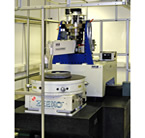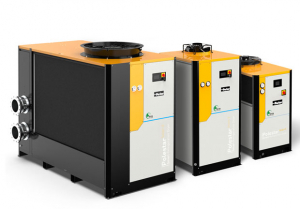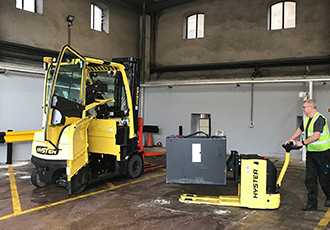Nanometric Measuring Technology Finds New Applications
3rd November 2011
Source:
ZEEKO Ltd

Surfaces that are nearly flat or spherical may be measured to nanometric accuracy using a device known as a swing-arm profilometer (SAP). There are only a handful of such machines worldwide, most of them in universities in the USA. There is only one in Britain, built in a collaboration between UK National Physical Laboratory and University College London, and adopted for further development by Leicestershire firm, Zeeko.
This one-metre capacity SAP is owned by Zeeko Ltd and is in use at the UK National Facility for Ultra Precision Surfaces, hosted within the National Facility for Ultra Precision Surfaces, OpTIC-Glyndŵr, St Asaph, North Wales. The SAP hardware is being used to create the next generation of measurement algorithms for characterising challenging meter-scale optical surfaces required for astronomy, high power laser systems and space instrumentation.
While this type of work will be a core application for SAPs, on-going tests in St Asaph have shown that the technology is scalable, permitting smaller metrology machines using the same measuring principle to be manufactured for quality control in other industries.
For example, this type of equipment would be well suited to measuring the spherical ball of a prosthetic hip. With the advent of joints in which two hard materials are used as the bearing surfaces, accurate form control is crucial to ensure longevity of the implant.
Evaluating the flatness of a high-precision machine tool's planar table is another potential application, as is inspection of lenses for high-end cameras.
The prerequisites for investment in a SAP are that the geometry of the component being inspected deviates from plano or spherical by no more than a few tens of millimetres over a metre; and that surface accuracy within a couple of hundred nanometres (nm) peak-to-valley (PV) needs to be measured. Zeeko is hopeful that advances that it is making in stitching software will bring measuring accuracy down to 10 nm PV after the exclusion of low order terms.
Hubble telescope error
The development of swing arm profilometry sprung from a need to cross-check traditional optical metrology methods, and to extend their range both in surface-departures, and to ground surfaces. The classic example is the Hubble Space Telescope's primary mirror, which was perfectly made to the wrong shape. Having a secondary instrument to validate measurements ensures that expensive mistakes such as this are not repeated.
Following Hubble, the international scientific community devised alternative methods to cross-check the traditional optical metrology methods. The SAP represents one such method to corroborate readings from a phase-shifting interferometer, which is the standard instrument for inspecting telescope mirror segments to ultra-precise levels of accuracy. The non-contact measurements that it takes are sometimes difficult to interpret, as was the case during the Hubble project.
The advantage of the SAP is that it has a high dynamic range, allowing it to measure components quickly and accurately over typically one metre, even when the surface departs from nominal by 10 or 15 millimetres. In contrast, an interferometer of reasonable price struggles if the surface geometry is more than a few tens of microns adrift.
In practice, the two inspection methods can be used in tandem. In telescope mirror segment production, for example, the SAP can provide an independent measure of the surface after grinding, and then after several subsequent iterations of polishing to allow the form to converge towards the optical design model. When the geometry is sufficiently accurate, the interferometer takes over and completes the measurements. (The problem with the Hubble Space Telescope was a systematic error caused by black paint flaking off a protective cap on a measuring rod used to define a critical distance in the test set-up. Light was reflected off the cap instead of the end of the rod, making the distance incorrect. The resulting wave-front error was polished into the Hubble mirror; a SAP could have picked this up.)
Furthermore, with Zeeko's metrology toolkit software, data from both measurement methods can be stitched together to build up a complete map of the surface. Other third-party manufacturers' data sets, such as from a Taylor Hobson Form Talysurf, could be similarly fused into a final map, if deemed appropriate.
A SAP comprises a rotary table supporting the component under test, a high-precision pivot air bearing, a rigid arm that swings across the surface, a counter balance for the arm, and a contact or optical probe. The set-up for measuring flat and spherical surfaces is different from when the component is concave or convex, in that the rotary axis of the arm bearing is set parallel to that of the rotary table.
By turning the table and swinging the arm under DC servomotor control, the probe describes repeated arcs (instead of concentric circular traces) across the surface of the component under test, capturing 3D profile data.
While this type of work will be a core application for SAPs, on-going tests in St Asaph have shown that the technology is scalable, permitting smaller metrology machines using the same measuring principle to be manufactured for quality control in other industries.
For example, this type of equipment would be well suited to measuring the spherical ball of a prosthetic hip. With the advent of joints in which two hard materials are used as the bearing surfaces, accurate form control is crucial to ensure longevity of the implant.
Evaluating the flatness of a high-precision machine tool's planar table is another potential application, as is inspection of lenses for high-end cameras.
The prerequisites for investment in a SAP are that the geometry of the component being inspected deviates from plano or spherical by no more than a few tens of millimetres over a metre; and that surface accuracy within a couple of hundred nanometres (nm) peak-to-valley (PV) needs to be measured. Zeeko is hopeful that advances that it is making in stitching software will bring measuring accuracy down to 10 nm PV after the exclusion of low order terms.
Hubble telescope error
The development of swing arm profilometry sprung from a need to cross-check traditional optical metrology methods, and to extend their range both in surface-departures, and to ground surfaces. The classic example is the Hubble Space Telescope's primary mirror, which was perfectly made to the wrong shape. Having a secondary instrument to validate measurements ensures that expensive mistakes such as this are not repeated.
Following Hubble, the international scientific community devised alternative methods to cross-check the traditional optical metrology methods. The SAP represents one such method to corroborate readings from a phase-shifting interferometer, which is the standard instrument for inspecting telescope mirror segments to ultra-precise levels of accuracy. The non-contact measurements that it takes are sometimes difficult to interpret, as was the case during the Hubble project.
The advantage of the SAP is that it has a high dynamic range, allowing it to measure components quickly and accurately over typically one metre, even when the surface departs from nominal by 10 or 15 millimetres. In contrast, an interferometer of reasonable price struggles if the surface geometry is more than a few tens of microns adrift.
In practice, the two inspection methods can be used in tandem. In telescope mirror segment production, for example, the SAP can provide an independent measure of the surface after grinding, and then after several subsequent iterations of polishing to allow the form to converge towards the optical design model. When the geometry is sufficiently accurate, the interferometer takes over and completes the measurements. (The problem with the Hubble Space Telescope was a systematic error caused by black paint flaking off a protective cap on a measuring rod used to define a critical distance in the test set-up. Light was reflected off the cap instead of the end of the rod, making the distance incorrect. The resulting wave-front error was polished into the Hubble mirror; a SAP could have picked this up.)
Furthermore, with Zeeko's metrology toolkit software, data from both measurement methods can be stitched together to build up a complete map of the surface. Other third-party manufacturers' data sets, such as from a Taylor Hobson Form Talysurf, could be similarly fused into a final map, if deemed appropriate.
A SAP comprises a rotary table supporting the component under test, a high-precision pivot air bearing, a rigid arm that swings across the surface, a counter balance for the arm, and a contact or optical probe. The set-up for measuring flat and spherical surfaces is different from when the component is concave or convex, in that the rotary axis of the arm bearing is set parallel to that of the rotary table.
By turning the table and swinging the arm under DC servomotor control, the probe describes repeated arcs (instead of concentric circular traces) across the surface of the component under test, capturing 3D profile data.
Similar articles
More from ZEEKO Ltd
- Nanometric Measuring Technology Finds New Applications 3rd November 2011
- Zeeko Named Midlands Region Winner for International Trade Awards 24th October 2011
- AUTOMATED POLISHING OF MOULDS TO REPLACE MANUAL FINISHING 22nd July 2011
- DAVID CAMERON SEES WORLD-BEATING POLISHING TECHNOLOGY 16th June 2011




.jpg)







Write a comment
No comments